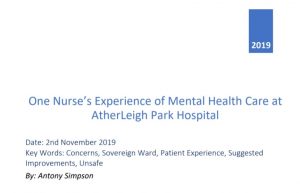Today is World Diabetes Day. People often struggle to understand diabetes and particularly type 1 diabetes which isn’t linked to diet, weight, a lack of exercise or age. So here’s a video from Diabetes UK that explains type 1 diabetes simply:

Here are some facts and statistics:
Quick facts about type 1 diabetes
- Approximately 400,000 people are currently living with type 1 diabetes in the UK, with over 29,000 of them children.
- Incidence is increasing by about four per cent each year, particularly in children under five, with a five percent increase each year in this age group over the last 20 years.
- Type 1 diabetes affects 96 per cent of all children with diabetes in England and Wales.
- Around 85 per cent of people diagnosed with type 1 diabetes have no family history of the condition.
- Although it used to be referred to as ‘juvenile diabetes’, around half of newly diagnosed cases are in people over the age of 18.
- The UK has one of the highest rates of type 1 diabetes in the world, for reasons that are currently unknown.
- A person with type 1 diabetes will have around 65,000 injections and measure their blood glucose over 80,000 times in their lifetime.
From: JDRF UK, last accessed: 11th November 2019.

Diabetes is a chronic long term health condition that requires a lot of management. For example I:
- Inject insulin 4 or 5 times everyday.
- Check and record my blood sugars before meals and two hours after meals.
- Check and record my blood sugars before and after driving.
- Finger pricking to read my blood sugars 8-15 times per day, prior to my Freestyle Libre (more on this below).
- Count the carbs in each meal.
- Have retinopathy screening, podiatry checks, annual reviews (with both my GP & Endocrine Consultant), see Diabetes Specialist Nurses and see Dietitians. You can only begin to imagine the number of health appointments I have in a year.
Having diabetes can be frustrating at times, as any little thing can affect the amount of glucose in my blood. Things that affect my blood sugar include: physical or mental illness, diet, exercise, the weather, even the amount and quality of sleep I’ve had.
Management and treatments have mostly stayed the same since I was diagnosed with diabetes. It often feels like I am trying to minimise the damage that diabetes causes to my body until better treatments are developed or until a cure is researched and widely available.
The biggest change to diabetes treatment in the last few years is the Freestyle Libre sensor for blood glucose readings. This my Consultant has described as revolutionary and I have to agree with her to a point. This means no finger pricking (unless unwell), but it is only half a job. Next diabetics need a pump that works with the Freestyle sensor to administer the right amounts of insulin automatically.
What’s your experience of type 1 diabetes? Leave a comment below.
Blog soon,
Antony

| Back in September I had a fifteen day stay admitted in mental health ward. Unfortunately, the care that I received and the care I observed other patients receiving was unsafe and did not meet the high standards of care that I would expect from our National Health Service (NHS).
I am proud to be a Nurse and despite still being unwell I feel that it was important to raise the issues I experienced and observed to prevent future patients from experiencing the same. |
I never like to complain about anything, but even more so with our NHS. In fact I’ve never complained about anything in the NHS. I have nothing but love and adoration for our NHS, after all it has saved my life several times and the lives of my loved ones countless times. I know it’s not perfect, but I also know that most of the staff do the very best that they can with extremely limited resources.
But I felt that I had an ethical and professional duty to raise these concerns to ensure that I was acting within the Nursing & Midwifery Council’s Code of Conduct (2018). So I sat down with notes I made at the time and wrote an exposé report.
The purpose of this report was to raise issues/concerns and give suggested actions for improvements.
I started the report with the positives, like:
- The vast majority of staff introduced themselves to other patients and myself.
- Staff appeared to complete the appropriate paperwork.
- Staff wore the appropriate badges & tabards.
- But most importantly staff showed kindness and compassion.
Then I listed each issue or concern that I had along with suggested actions for improvement.
For example, a number of staff reported having “no idea” about diabetes. So I recommended:
- That all staff should receive training on diabetes that includes the difference between type 1 & 2 diabetes.
- All staff should be reminded that best practice is to take a BM reading before a meal and 2 hours after a meal.
- Staff should be reminded of any policies or procedures relating to diabetes care.
I then sent the report to the Complaints Team as a formal complaint, PALS, the Ward Manager (via PALS), the Lead Consultant Psychiatrist (via PALS), the Chief Executive, the Chief Nurse and Deputy Chief Executive and The Governance Team at my local Clinical Commissioning Group.
This was on a Saturday evening. I didn’t expect to hear anything until the following week. But I got an email back from the Chief Executive (on a Saturday!) thanking me for my report and assuring me that the Complaints Team would be in touch.
Since The Complaints Team have been in touch by email. It reads like they are taking my report extremely seriously which is good to read.
I’ll keep you updated.
Antony

In recent years the pharmacological principle of prescribing and administering the minimum dose of medication to get the desired effect has become common place in medicine. Despite not being a Doctor or Nurse Prescriber I have come to believe that this approach is fundamentally wrong. In this post I explain why.
Let me explain why the theory and practice has become so popular. It has lots of benefits. It helps prevent patients being overdosed on medications, minimises the likelihood and severity of side effects; can prevent or reduce the risk of patients becoming tolerant to medications and microbes from developing drug resistance (such as antibiotic resistance).
These benefits all sound good, so lets looks at the risks and why I believe the risks outweigh the benefits – put simply why I think this approach is wrong.
The biggest risk is that patients get under-dosed, leaving them in pain or suffering due to Doctors and Nurses being too cautious. Another risk is that Doctors and Nurses are always looking to reduce doses at medication reviews. This could be physically, mentally and emotionally harmful to the patient. Some may argue that pathways are in place to prevent under-dosing and harm. But pathways don’t always account for the complexity of the individual patients.
Here are some examples of when this theory of giving the minimum amount of medication to get the desired effect doesn’t work:
- A patient brakes their arm and has the bone sticking out. They are understandably in a lot of acute pain. However a pathway, Doctor or Nurse may choose to start them on paracetamol and work up to stronger painkillers. In this case the patient is likely to need Morphine, which is at the top of the pain management pathway. This may result in several hours (or more) of severe pain.
- A patient with chronic back pain attends a Pain Service for medication review. After the initial assessment, the Doctor or Nurse decides to lower doses of medications despite the patient saying that they’re struggling with the pain. They refer to Physiotherapy – a good decision, but still reduce the doses of medications. This leads to anxiety, possible depression and more physical pain.
- An elderly patient has a urine infection and type 2 diabetes. After several GP visits due to constantly needing the toilet, she gets antibiotics. However they are of the lowest dose, indicated by a urine infection pathway. The patient has to return to the GP to get a higher dose. During this time her blood sugars are high, leading to even more urination, the risk of dehydration and other associated complications of having a high blood sugar over a prolonged period of time.
- A patient with mental illness such as bipolar isn’t put on high enough doses of antipsychotics and/or antidepressants. They are given the dose that is as little as possible and it is not increased despite the patient asking for this. This means that the patient has continual relapses and repeated admissions to mental health wards.
I try to avoid writing about things that could cause controversy. But my recent 15 day stay in a mental health ward and experience with community mental health services has left me having being given less than the standard doses advised in the BNF on two mood stabilisers. I believe that standard doses of medications exist for a reason. These are levels of medication that experienced clinicians through research have found to be effective.
I now face an uphill struggle and a battle to get medications I need increasing increased due to this theory. This is why I believe it is fundamentally wrong. Because of the risks of under-dosing and causing harm. I’m sure I’m not the only one affected by this principle, it is no doubt many others across the country and Western world.
Write soon,
Antony




